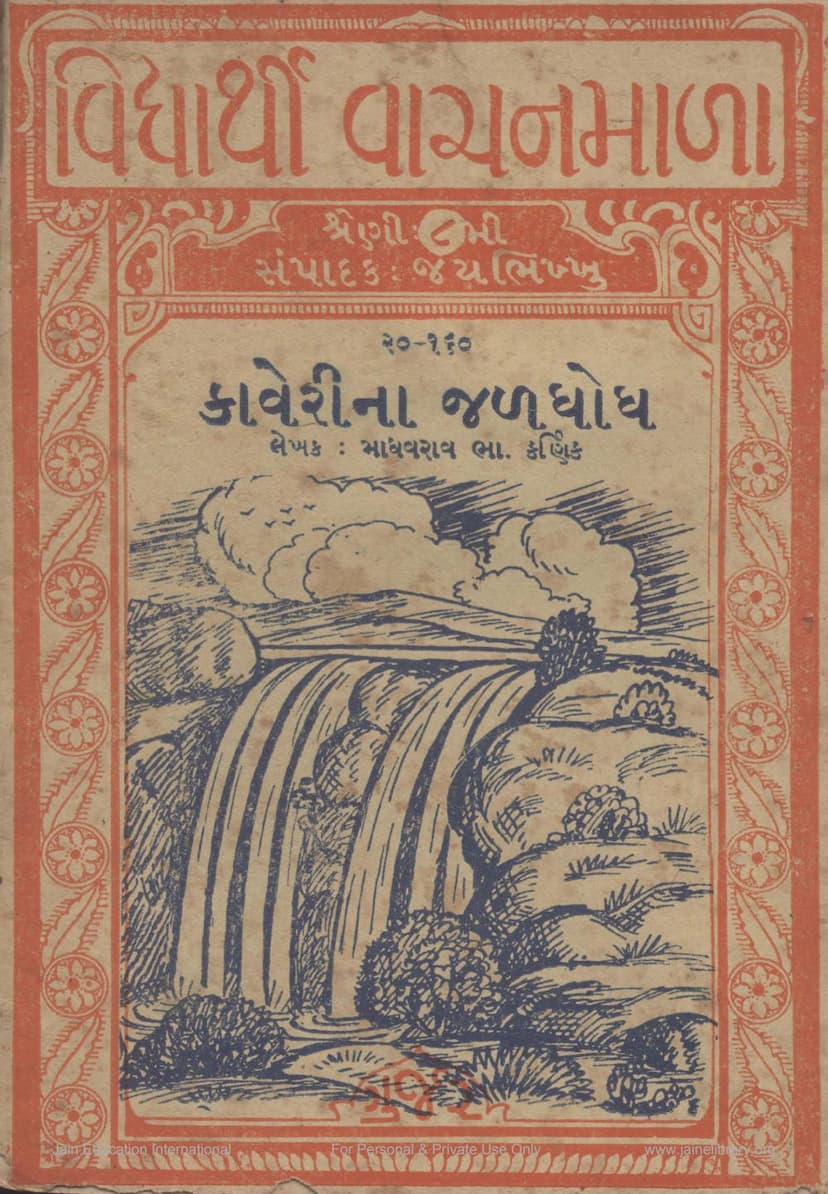Kaverina Jaldhodh
Added to library: September 2, 2025

Summary
This document is a chapter from the "Vidyarthi Vachanmala" (Student Reading Series), specifically the eighth series, titled "Kaveri ane Tena Jaldhodh" (Kaveri and its Waterfalls). The author is Madhavrav B. Karnik. The publisher is Vidyarthi Vachanmala.
The text primarily focuses on the Kaveri River, its origin, course, significance, and the famous Sivasamudram waterfalls. Here's a summary of the key points:
Introduction to Kaveri:
- The Kaveri River is presented as a major and sacred river in South India, comparable to the Ganga and Yamuna in North India.
- It is revered for its association with important religious and historical figures who lived and preached on its banks.
- The river is also called "Dakshinaganga" (Ganga of the South).
Origin and Course:
- The Kaveri originates from the Brahmagiri mountain in the Kodagu (Coorg) district of Mysore.
- The birthplace is described as a beautiful and peaceful location with crystal-clear, sweet, and naturally filtered water.
- The river flows through Mysore, then enters the plains of Madras Presidency, and finally empties into the Bay of Bengal.
- Its length is approximately 475 miles, and it irrigates over 28,000 square miles of land.
Significance and Irrigation:
- The Kaveri is crucial for agriculture in South India, earning it the title "Annapurna" (goddess of food).
- Numerous canals have been dug from the river, irrigating vast tracts of land and contributing to the production of grains.
- The text highlights the significant revenue generated for the Mysore government from these canals.
Features of the River:
- The river's journey is described with evocative language, likening it to a playful maiden and a majestic elephant.
- It passes through rocky terrains and fertile plains, with its speed varying along its course.
- Several tributaries join the Kaveri, augmenting its flow.
- The text mentions bridges built over the river, including the Wellesley Bridge and the Lushington Bridge at Sivasamudram.
Sivasamudram Waterfalls:
- The Sivasamudram waterfalls are described as a world-renowned and unparalleled natural wonder.
- The falls are formed by the river splitting into two branches, cascading down from a height of 327 feet.
- The two main falls are known as Gaganachukki (western) and Bharachukki (eastern).
- The immense power of the waterfalls is harnessed to generate hydroelectricity.
Hydroelectric Power Generation:
- A significant hydroelectric power station is located at Sivasamudram.
- The electricity generated here is supplied to the Kolar gold mines (92 miles away) and the city of Bangalore (59 miles away).
- The text details the growth in power generation capacity from 1902 to 1905, highlighting the scale of this hydroelectric project.
Other Notable Aspects:
- The text mentions the towns of Yedayathara, Srirangapatnam, and Talakad along the Kaveri.
- Crocodiles are observed in the river, but they are considered harmless to fishermen and are even fed by people at certain locations.
- The river's water is used for irrigation in both Mysore and Madras presidencies, contributing to the region's prosperity.
- The "Maha Canal" (Vadi Naher), built in the 11th century by the Chola dynasty, is mentioned as a significant ancient irrigation project.
- The text also touches upon the engineering efforts made by the British to improve irrigation from the Kaveri and its canals.
Religious and Cultural Significance:
- The Kaveri is considered a sacred river, and a dip in its waters is believed to wash away sins and grant liberation.
- Many Hindus bathe in the river annually.
- The site of Talakaveri, where a small river first meets the Kaveri, is a pilgrimage destination with many temples and a large annual fair.
In essence, "Kaveri ane Tena Jaldhodh" is an informative and appreciative account of the Kaveri River, emphasizing its natural beauty, its vital role in the economy and life of South India, and its deep cultural and religious significance. The text also highlights the engineering marvels associated with harnessing its power.